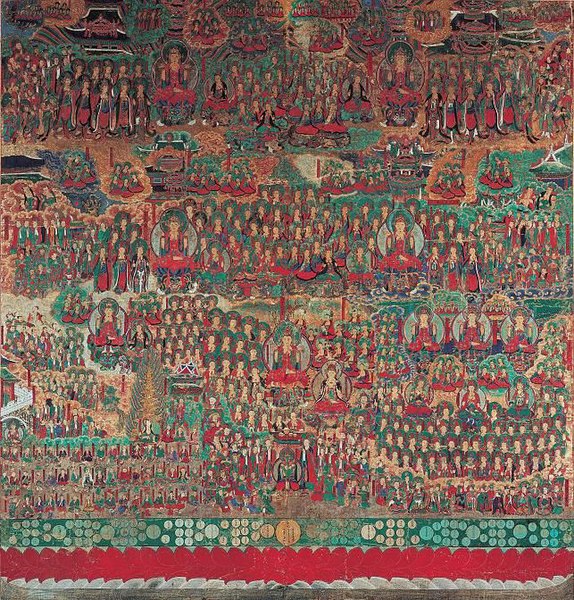The Gaṇḍavyūha Sutra is a Buddhist Mahayana Sutra of Indian origin dating roughly c. 200 to 300 CE. The term Gaṇḍavyūha is obscure and has been translated variously as Stem Array, Supreme Array, Excellent Manifestation. The Sanskrit gaṇḍi can mean “stem” or “stalk” and “pieces” or “parts” or “sections,” as well as "the trunk of a tree from the root to the beginning of the branches"). Peter Alan Roberts notes that "as the sūtra is composed of a series of episodes in which Sudhana meets a succession of teachers, the intended meaning could well have been 'an array of parts' or, more freely, 'a series of episodes.'" He also notes that the term gaṇḍa can also mean "great" or "supreme" in some circumstances and thus some translators have rendered this compound as Supreme Array.
The Chinese translations indicate that the sutra also went by another title in the 7th century which can be reconstructed into Sanskrit as Dharmadhātu-praveśana.

Sudhana learning from one of the fifty-two teachers along his journey toward enlightenment. Sanskrit manuscript, 11-12th century.
Seven Leaves from a Manuscript of the Gandavyuha-sutra, Eastern India, Pala period.
The Buddhāvataṃsaka-nāma-mahāvaipulya-sūtra is one of the most influential Mahāyāna sutras of East Asian Buddhism. It is often referred to in short as the Avataṃsaka Sūtra. In Classical Sanskrit, avataṃsaka means garland, wreath, or any circular ornament, such as an earring. Thus, the title may be rendered in English as A Garland of Buddhas, Buddha Ornaments, or Buddha's Garland. In Buddhist Hybrid Sanskrit, the term avataṃsaka means "a great number," "a multitude," or "a collection." This is matched by the Tibetan title of the sutra, which is A Multitude of Buddhas.
Covers of a Korean golden pigment sutra chapter. Indigo dyed paper, with rows of golden flower blossoms, and a title cartouche, c. 1400.
Illustration of the Avatamsaka Sutra at Songgwangsa in Suncheon, Korea. Joseon dynasty, 1644.
Jin Dynasty (1115–1234) statue of Vairocana (Chinese: 大日如来; pinyin: Dàrì Rúlái), Shanhua Temple, Datong, Shanxi, China.
A Korean wooden depiction of the "three holy ones" (Vairocana Buddha, Samantabhadra and Manjushri), a triad associated with the Avatamsaka sutra, Songgwangsa temple in Suncheon.






